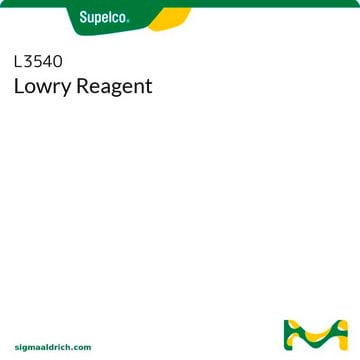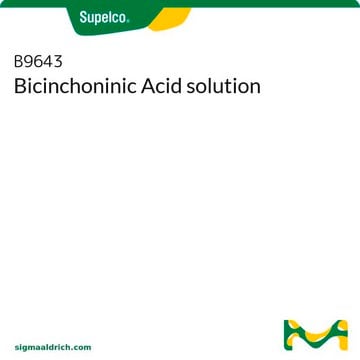B6916
Bradford Reagent
for 0.1-1.4 mg/ml protein
Synonim(y):
Coomassie dye binding protein assay, Coomassie dye binding protein assay, Protein dye reagent, Protein dye reagent
About This Item
Polecane produkty
Powiązane kategorie
Opis ogólny
Zastosowanie
Cechy i korzyści
- The reagent is ready to use. No mixing or dilution required.
- Color development is rapid. Only a five minute incubation and then the sample is read a 595 nm.
- Reducing sugars and reducing substances along with thiols do not interfere with this reagent.
- Reagent is suitable for micro (1-10 μg/ml) and standard (50-1400 μg/ml) assays.
- Can be used in microwell plate assays.
- Inexpensive assay.
Informacje prawne
Zastosowanie
najczęściej kupowane z tym produktem
produkt powiązany
Hasło ostrzegawcze
Warning
Zwroty wskazujące rodzaj zagrożenia
Zwroty wskazujące środki ostrożności
Klasyfikacja zagrożeń
Eye Irrit. 2 - Met. Corr. 1 - Skin Irrit. 2 - STOT SE 2
Organy docelowe
Eyes,Central nervous system
Kod klasy składowania
8B - Non-combustible corrosive hazardous materials
Klasa zagrożenia wodnego (WGK)
WGK 1
Temperatura zapłonu (°F)
Not applicable
Temperatura zapłonu (°C)
Not applicable
Certyfikaty analizy (CoA)
Poszukaj Certyfikaty analizy (CoA), wpisując numer partii/serii produktów. Numery serii i partii można znaleźć na etykiecie produktu po słowach „seria” lub „partia”.
Masz już ten produkt?
Dokumenty związane z niedawno zakupionymi produktami zostały zamieszczone w Bibliotece dokumentów.
Klienci oglądali również te produkty
Produkty
The field of proteomics is continually looking for new ways to investigate protein dynamics within complex biological samples. Recently, many researchers have begun to use RNA interference (RNAi) as a method of manipulating protein levels within their samples, but the ability to accurately determine these protein amounts remains a challenge. Fortunately, over the past decade, the field of proteomics has witnessed significant advances in the area of mass spectrometry. These advances, both in instrumentation and methodology, are providing researchers with sensitive assays for both identification and quantification of proteins within complex samples. This discussion will highlight some of these methodologies, namely the use of Multiple Reaction Monitoring (MRM) and Protein-AQUA.
Protokoły
To determine protein content, the Warburg-Christian method refers to measuring protein samples at 280 nm using a spectrophotometer.
Zasady i dobre praktyki w zakresie przygotowywania próbek do Western blot z hodowli komórkowych i próbek tkanek.
Rules and good practice in sample preparation for Western blot sample preparation from cell culture and tissue samples.
Powiązane treści
Metody kwantyfikacji białek, odczynniki i technologia testów immunologicznych do dokładnego pomiaru stężenia białek w różnych próbkach.
Protein quantification methods, reagents, and immunoassay technology for accurately measuring the protein concentrations in a variety of samples.
Products for traditional and alternative protein quantitation techniques available, including BCA, Bradford, Lowry, and more.
Dostępne są produkty do tradycyjnych i alternatywnych technik kwantyfikacji białek, w tym BCA, Bradford, Lowry i innych.
Nasz zespół naukowców ma doświadczenie we wszystkich obszarach badań, w tym w naukach przyrodniczych, materiałoznawstwie, syntezie chemicznej, chromatografii, analityce i wielu innych dziedzinach.
Skontaktuj się z zespołem ds. pomocy technicznej












